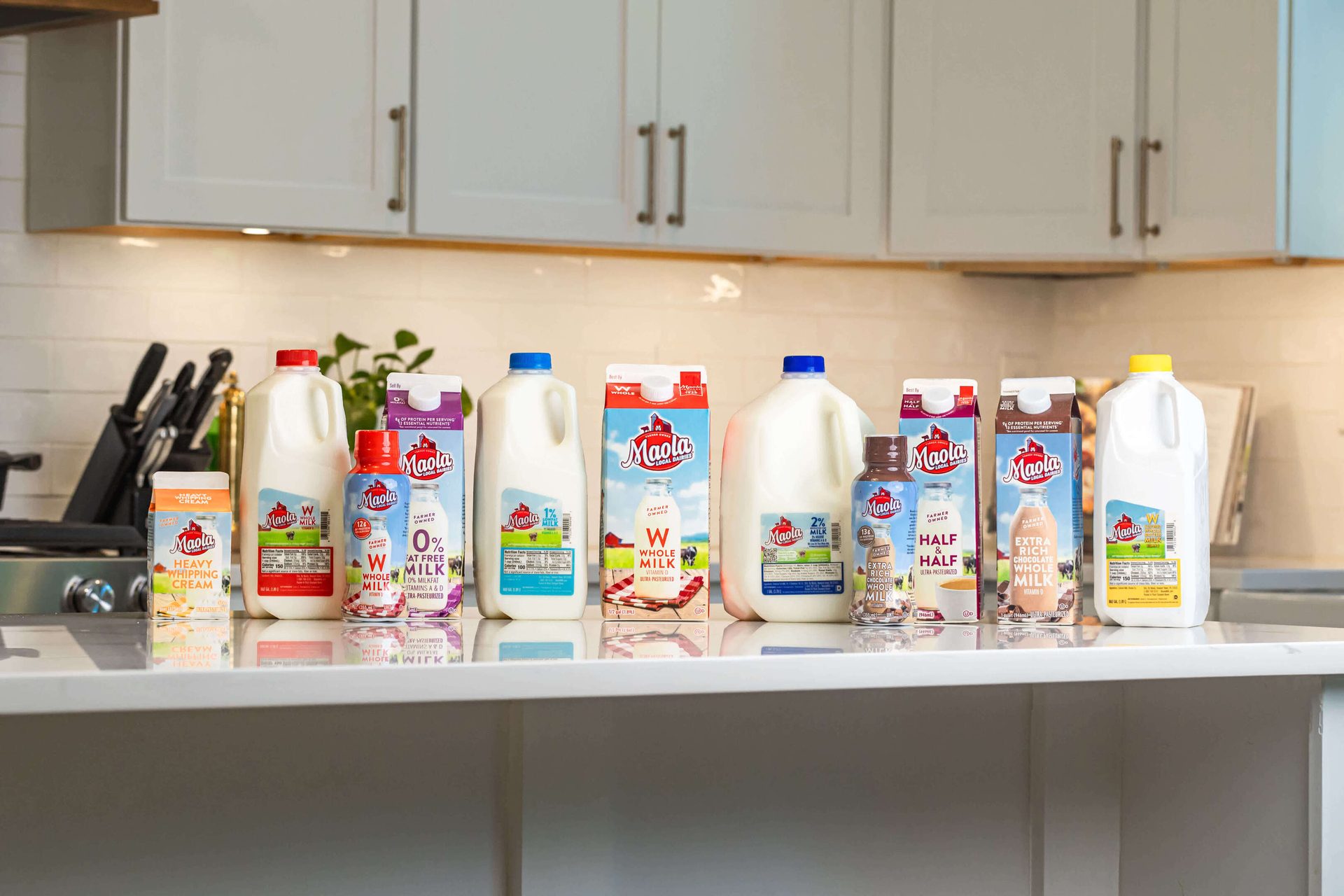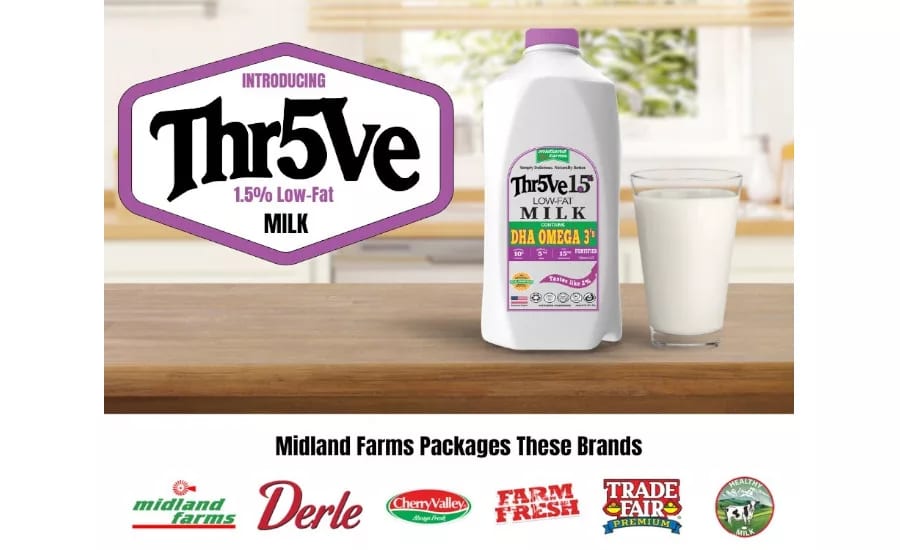
Milk sales swirl like fall winds
A “Love Story” for Milk

Circana’s Senior Vice President of Client Insights Melissa Altobelli states: “Milk’s recent dollar growth has been largely driven by price increases, while volume has seen a slight decline [of -0.4%]. This growth is primarily driven by price increases, with price per volume up +4.6%. In contrast, plant-based milk continues to face headwinds, declining -3.4% in dollar sales and -6.4% in volume.”
Maola Local Dairies, a cooperative with six plants in the mid-Atlantic corridor in Virginia, Maryland, Pennsylvania and North Carolina, offers several SKUs of milk, including Whole, Reduced Fat, Low Fat, and most recently, Lactose Free. Photo courtesy of Maola Local Dairies.

“Like a balcony in summer air,” the overall milk category is ascending new heights with $20.4 billion in dollar sales and a year-over-year (YoY) increase of 3.5% for the 52 weeks ending Sept. 7, according to data from Circana. Refrigerated white milk and refrigerated flavored milk were “in tune” with dollar sales of $17.6 billion and $1.8 billion, respectively, and YoY growth of 4.3% and 4.1%, the Chicago-based market research firm states.
Taylor Swift was just 20 when she became the youngest songwriter to win Song of the Year for “Love Story,” at the 2009 BMI Pop Awards. Off her Grammy-award-winning Fearless album, Swift sings about Romeo “saving her” from others “tryna to tell me how to feel.” While acknowledging a difficult but real love, the princess encourages her prince not to be afraid because “we’ll make it out of this mess” since “It's a love story, baby, just say, ‘Yes.’”
After a decades-long decline and fluctuating volume, consumers are saying “yes” and “loving” the nutritional value of milk, sticking with “real” dairy as the most familiar option versus the perceived heavily processed plant-based dairy alternatives.
Made with 100% milk, Lactaid produces more than 50 SKUs of lactose-free products, including milks, ice creams, sour cream and cottage cheese. Photos courtesy of Kenvue Brands LLC.
Plant-based milk is out of tune. For the 52 weeks ending Sept.7, plant-based milk generated dollar sales of $2.4 billion and a YoY decline of -3.3%. While refrigerated almond milk was the top segment with dollar sales of $2.4 billion, sales declined -6.3% over the prior-year period. Refrigerated oat milk and refrigerated soy milk had sales of $597 million (-0.3%) and $185 million (2.9%), respectively, per Circana data.
A bright spot within alternative dairy at the No. 4 spot, refrigerated coconut milk saw double-digit growth of 15.2% and annual dollar sales of $125 million. Albeit from a small base, refrigerated blends rose 5,5202%, clocking in at $3.8 million. Refrigerated kefir is "shooting for the stars" with a YoY increase of 25.1% to $226 million in dollar sales.

Wellness-oriented dairy wins
Maria Mascaraque, senior insight manager at Chicago-based Euromonitor International, points out that functional benefits targeting gut health, energy, immunity and mental well-being are resonating in the dairy industry.
“Botanical ingredients like matcha, ginger, lavender and citrus are being incorporated to address specific need states, while protein isolates and probiotics are expanding across milk and yogurt formats,” Mascaraque explains. “For example, according to Euromonitor’s Innovation database, high-protein new product launches in yogurt and sour milk products rose by 63% in 2024, underscoring the growing demand for wellness-oriented dairy and for this claim in particular.”
The company’s Sustainability Claims tracker notes that in 2024 alone, dairy products with “natural” claims accounted for $46 billion in value sales across 25 key markets.
Circana’s Altobelli suggests that while the milk category’s price per volume is up 4.6%, consumers are shifting toward lower-calorie diets and prioritizing high-protein options.
“[This is] leading to increased competition for milk from other categories offering similar nutritional benefits. Additionally, with household penetration already high, it’s increasingly difficult to attract new buyers to the category,” she says.
To entice more consumers, however, more dairies and cooperatives such as Maola Local Dairies, Herndon, Va., are manufacturing more SKUs and packaging options for consumers. These include shelf-stable ultra-pasteurized milk which has a longer shelf life than regular pasteurized milk but still requires refrigeration after opening, the company says.
Under parent company Maryland & Virginia Milk Producers Cooperative Association, Reston, Va., the Maola cooperative, using milk from about 1,000 family farms, processes milk at six dairy plants along the mid-Atlantic corridor in Virginia, Maryland, Pennsylvania and North Carolina. The coop’s extensive milk portfolio includes Whole Milk, Reduced-Fat Milk, Fat-Free Milk, Chocolate Milk and Buttermilk. In also produces seasonal Eggnog in Ultra-Pasteurized Half Gallons and Quarts.
Maola’s newest lineup, Ultra Pasteurized Lactose-Free Milk, made from 100% dairy milk but without the lactose, is available in half-gallon sizes in Whole and Reduced Fat varieties, while its Lactose Free Milk also is available in shelf-stable 8-ounce single serves in 1% Low Fat and Fat Free Chocolate Milk.
Euromonitor International’s Mascaraque and Circana’s Altobelli concur that shelf-stable products, “free from” and no artificial sweeteners are reflecting a broader shift toward transparency, simplicity and naturalness in ingredient lists.
Designed to appeal to consumers who seek added benefits from their beverages, TruMoo Zero provides 13 grams of protein, which is 50% more protein than regular chocolate milk and no added sugar, the company states. Photo courtesy of Dairy Farmers of America.

“In the case of the milk category, an important trend is shelf-stable formats, such as sachets formats launched in Argentina by Lacteos Silvia SRL, expanding access in price-sensitive markets,” Mascaraque says. “While in mature markets, functional milk drinks fortified with protein, probiotics and botanicals are growing as wellness staples, catering to consumers seeking gut health, energy and cognitive support.”
Altobelli adds: “Ultra-filtered milks, like fairlife, deliver on multiple fronts: lower sugar, higher protein, and lactose-free: all in one product. This combination of benefits has helped fairlife consistently outperform the category and attract new buyers year after year.
“Grass-fed milk is another area gaining traction,” Altobelli continues. “While still a smaller segment, it holds strong potential. Grass-fed dairy offers a superior nutritional profile, with higher levels of omega-3 fatty acids, vitamin K2, and antioxidants compared to milk from grain-fed cows. Beyond nutrition, grass-fed dairy appeals to environmentally conscious consumers due to its lower carbon footprint and more natural farming practices. It also delivers a richer, creamier flavor, which enhances the overall consumption experience.”
In October, Midland Farms, Menands, N.Y., launched Thr5ve 1.5 Low-Fat Milk, a milk product enriched with DHA omega-3s for health benefits and fortified with skim powder providing enhanced flavor and mouthfeel, along with vitamins A and D.
Altobelli cites Organic Valley’s Family First as an alternative to the wave of lactose-free products. “With 50mg of DHA omega-3 per serving and a positioning as a family-friendly functional milk, Family First has gained meaningful traction, driven by strong repeat rates and new category buyers, although the overall DHA milk segment continues to decline,” she says.
When discussing the top flavors/varieties in the milk category, plain remains the top choice across both dairy and plant-based milk, according to Altobelli.
“In dairy milk, chocolate ranks as the second most popular flavor, while vanilla holds that spot in plant-based milk,” she concludes. “Conventional dairy milk still accounts for the majority of volume, but growth is being driven by organic and lactose-free options. …Many recent lactose-free innovations are similar to fairlife, focusing on higher protein, ultra-filtration, and reduced sugar. Brands like Milk50, Darigold Nutrition+, and Pioneer Pastures, along with several private-label offerings, have entered the space. However, none have matched fairlife’s success or consumer loyalty.” DF
Midland Farms, Menands, N.Y., recently launched Thr5ve 1.5 Low-Fat Milk, a milk product enriched with DHA Omega-3s for health benefits. Photo courtesy of Midland Farms.

“According to Euromonitor’s forecast, sour milk products are expected to be among the fastest-growing global categories, with a CAGR of 4.7% between 2025 and 2030 (constant terms, fixed 2025 terms),” she says. “This reflects a broader consumer shift toward fermented and microbiome-supporting foods. Brands such as Biotiful in the UK have seen rapid growth by positioning themselves squarely within the gut health space.”
Lactose-free milk also is experiencing significant growth, driven primarily by the success of ultra-filtered options like fairlife, which has “sparked a wave of innovation, with many brands now launching their own lactose-free offerings to meet growing demand,” Altobelli says.
Lactose free and GLPs
Altobelli and Mascaraque also note the significance of lactose free, higher protein, reduced sugar, fermented products and GLP-1 on driving sales within the milk category.
“The impact of GLP-1 is also impacting consumer buying decisions,” Altobelli explains. “Many dairy categories are seeing bolstered sales as a result of the GLP-1 uptake including Yogurt, Cottage Cheese and Value-added milk as a result of GLP-1 user focus on high protein and low fat and low sugar products.”
Cultured dairy is also gaining significant traction, particularly formats like sour milk products such as kefir, which are increasingly valued for their gut health benefits, Mascaraque states.
Opening image courtesy of lisegagne / E+ / Getty Images.
